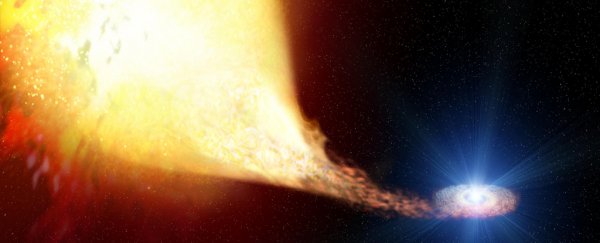Roughly 55 million light years away, in the galaxy NGC 5643, an exploding star sent a wave of gas and radiation crashing into a neighbouring sun. And it was just what astrophysicists had been waiting for.
To the researchers who caught a glimpse of this cataclysmic event it was solid evidence that this type of supernova could emerge from different processes, potentially affecting how vast distances in space are currently measured.
The team of astrophysicists from University of California Santa Barbara (UCSB) used the Las Cumbres Observatory (LCO) to gather data on an event that was expected to help resolve a question that has been debated for more than half a century.
"We've been looking for this effect – a supernova crashing into its companion star – since it was predicted in 2010," says one of the researchers, Griffin Hosseinzadeh from UCSB.
"Hints have been seen before, but this time the evidence is overwhelming."
The explosion itself, named SN 2017cbv, seemed like a run-of-the-mill Type 1a supernova.
These are thought to be caused by carbon-oxygen white dwarf stars in a binary system greedily wolfing down material from their companions. A star will do so until passing its Chandrasekhar limit - the maximum mass a white dwarf can have - only to violently collapse and spew out a space tsunami of gas at about 10,000 kilometres per second.
These apocalyptic events produce some of the Universe's brightest fireworks, with a magnitude of brightness that varies so little, a typical Type 1a can act as a kind of yardstick across the mindboggling distances of intergalactic space.
Changes in the supernova's brightness over time has proven so handy as a so-called 'cosmic candle', they have been used for nearly a century to argue the Universe is expanding.
A big part of the problem, however, is we know so little about how or why stars go bang.
"One of the greatest discoveries of the century is based on these things and we don't even know what they are, really," Hosseinzadeh told Shannon Hall at Nature News.
Two working theories revolve around whether both stars are white dwarfs or not.
In the single-degenerate scenario, a carbon-oxygen white dwarf strips material off its partner, typically a star like our Sun or a puffed up red giant.
The double-degenerate scenario happens when a partner is another white dwarf, circling around its companion until the pair merges into a single body over the Chandrasekhar limit.
Fewer than 20 percent of type 1a supernovae are thought to be single-degenerate types, though since they don't tend to leave behind much evidence to study, that figure and their nature has been hotly debated.
In fact, it was only in 2004 that a stellar 'survivor' of such a blast was even detected.
"Supernovae can wreck nearby stars … releasing unbelievable amounts of energy in the process," says researcher Andy Howell from UCSB.
Finally, astronomers have detected hard evidence of a companion in the immediate wake of a Type 1a supernova, presented in the form of a spike of blue in the spectrum of the shockwave as it washed over the nearby star.
Once the supernova was spotted, LCO's global network of 18 telescopes was able to track and record signals from the expanding ball of gas at an unprecedented level of detail.
"With LCO's ability to monitor the supernova every few hours, we were able to see the full extent of the rise and fall of the blue glow for the first time," says Hosseinzadeh.
"Conventional telescopes would have had only a data point or two and missed it."
Identifying such strong signs of a single-degenerate Type 1a supernova meant the researchers could confidently state there were indeed two different ways these events could unfold.
The idea that not all Type 1a supernovae are identical isn't new. A study in 2016 claimed the luminosity of a particular event could vary depending on its composition, putting the precision of the cosmic candle standard into question.
Astronomers might now need to consider the consequences of these supernovae being sparked by different types of companion star.
It's unlikely that the cosmic candle will be adjusted significantly, but as our figures on the Universe's expansion are refined, those subtle differences might become more important.
The research is currently on the pre-publish website arxiv.org, and has been accepted into the Astrophysical Journal Letters.
